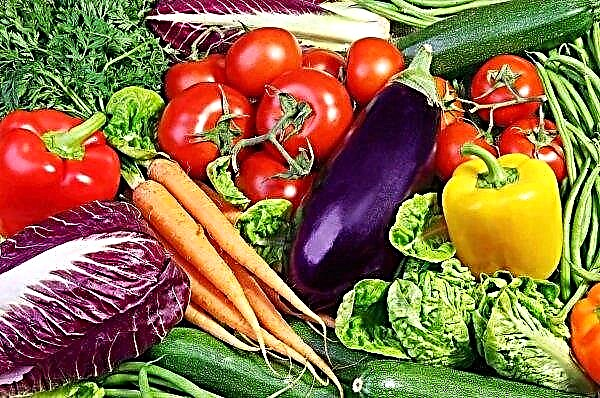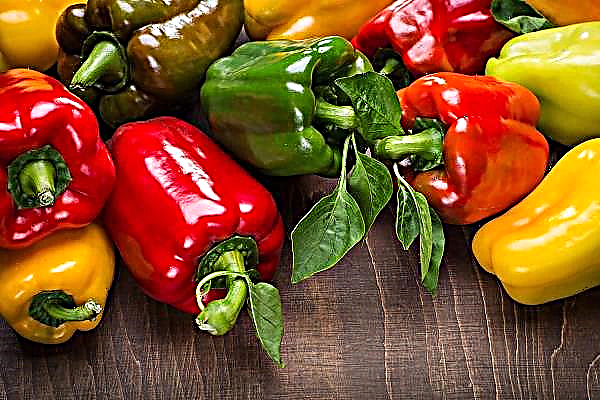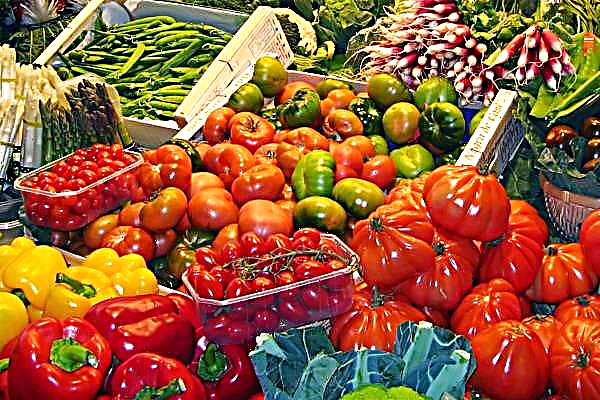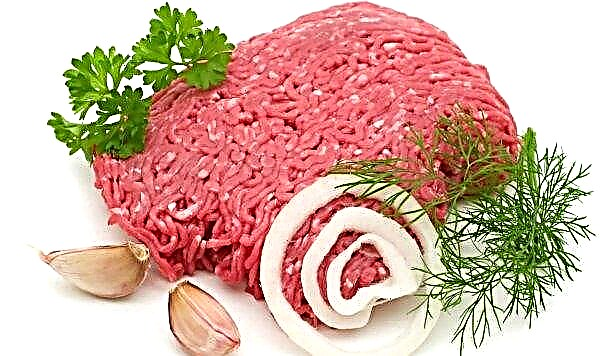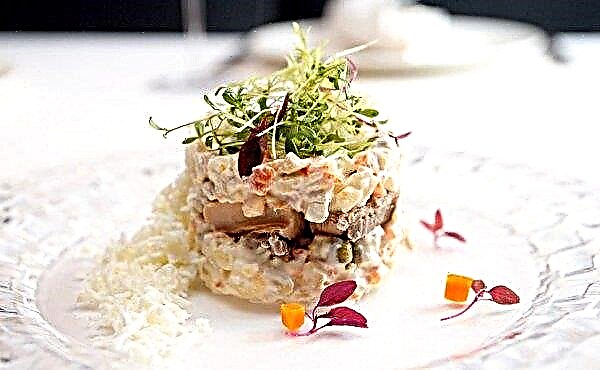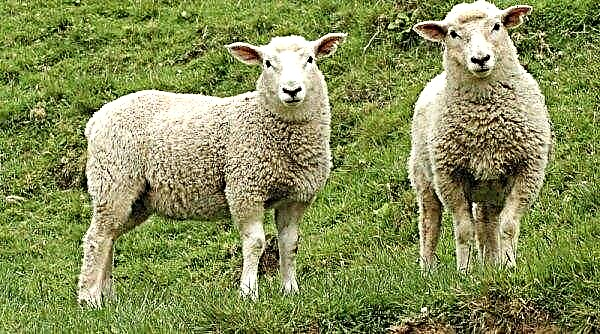Beetroot is a root crop that appears at least once a week on the tables of most of our fellow citizens. Such popular dishes as borsch and vinaigrette have firmly won one of the top positions in national cuisine. In this article we will get acquainted with the characteristics of Pablo F1 beets, learn all about its cultivation, pests and diseases.
Description and characteristic
Red beets Pablo F1 is not a variety, it is a hybrid in the first generation. The hybrid is obtained by crossing several varieties. It contains an increased amount of betanin, which is responsible for the removal of radionuclides from the body. The plant is not too demanding, but it has a high yield (7 kg / 1 m²), can withstand prolonged low temperatures. The beetroot hybrid Pablo F1 is distinguished by good taste and relative resistance to fungal diseases.
Did you know? Beet fruits contain many valuable organic compounds, such as proteins, fiber, organic acids (folic, malic, citric, tartaric and oxalic). It also contains vitamins A, B, C, K, minerals (potassium, calcium, phosphorus, magnesium, sodium, iron), antioxidants (mainly betanin) and sugar.
Selection history
The hybrid was obtained by breeders of the Dutch company Bejo Zaden. Pablo F1 is grown in the fields of Russia, Moldova, Ukraine and Poland. Areas with a harsh climate are suitable for growing, as this hybrid is resistant to cold.
Description of the fetus
This hybrid is good in that its fruit is not prone to overgrowth. This size is convenient for cooking (one beet is used for one borsch or vinaigrette). A remarkable property of Pablo F1 is that when boiled in a peel, the beets retain a bright color of pulp, do not fade.
Description of the hybrid Pablo F1:
- Bright green leaves with burgundy streaks grow vertically, leafy plants are average.
- The shape of the leaf is oval, the edge of the leaf is slightly wavy.
- Root crops have a round shape, diameter - 12-15 cm, weight - 110-180 g.
- The color of the pulp is a bright burgundy, thin skin on the surface of the fruit has a slightly duller color.
Advantages and disadvantages
Like any beet variety or hybrid, Pablo F1 beets have both positive aspects and disadvantages.
- Pros:
- high productivity;
- sweet taste;
- preservation of the color of the pulp during heat treatment;
- high content of betanine in the roots;
- compactness of the fetus;
- resistance to prolonged low temperatures;
- undemanding to soil fertility;
- resistance to certain diseases (cercosporosis, scab) and crop pests.

- Minuses:
- tendency to peronosporosis;
- tendency to early flowering and the formation of seed arrows;
- young plants are invaded by beet weevil.
Sowing seeds in open ground
To accelerate the germination of seeds, they are soaked in water for 24 hours. During this time, water is absorbed into the shell of the seeds, and they swell. This supply of water is enough for a seed to germinate. Often, soaked seeds are additionally treated in a liquid solution of insecticides, for example, in Aktara. This is an additional precaution against a dangerous pest of beet crops - weevil.
In small beds, the sowing of the Pablo F1 hybrid is carried out manually, in large areas the seeds are sown using seeders. Sow the culture in rows parallel to each other in the furrows.
Did you know? After heat treatment, boiled beetroot loses some useful substances, but in its raw form (for example, in the form of juice) it supports the circulatory system, facilitates the removal of toxins, helps fight infections, stabilizes cholesterol, regulates blood pressure and protects the body from the development of cancer.
The timing
Seeds are sown in early spring, as soon as the snow comes off the fields, the soil dries, a stable plus temperature is established and until moisture has left the ground. Soil moisture is a prerequisite for seed germination.
Seeds germinate at temperatures above + 8 ° C, the optimum germination temperature is +18 ... + 20 ° C. In the southern regions, sowing is carried out earlier, in the northern regions, fearing return frosts, this crop is sown later.
Due to the rapid growth of culture and a tendency to early flowering and the formation of seed arrows, an early sowing date is recommended for the use of fruits in summer and autumn. Depending on the purpose of the fruit, sowing can be carried out from mid-April (for processing, storage) until July (for late production).
Did you know? Doctors do not recommend everyone to use fresh beetroot juice. The substance that stains the beet root in red (betanin) is indeed a valuable antioxidant, but since it contains nitrates, it is undesirable to give it to children.
Seat selection and crop rotation
This root crop requires fertile land and good sun exposure, it will not grow in the shade or partial shade.
Growing beets is not difficult, but vegetables are quite demanding. Despite the fact that they grow on almost any well-treated soil, still root crops prefer fertile, humus and moist soils with a neutral or slightly alkaline pH (6.5–7.0). They do not tolerate acidic, cold, dense and clay soils, and also react poorly to drought and lack of fertilizer.
Beetroot also requires a warm climate and sunlight, since it is not a frost-resistant plant. When growing, crop rotation must be observed. You can’t grow beets in the same area for 3-4 years, it is also undesirable to grow a crop after other root crops. Beet roots do not tolerate close occurrence of groundwater, therefore, beetroot field should be avoided in the lowland.
Good predecessors for beets:
- cereals;
- legumes;
- pumpkin;
- garlic.
- cabbage;
- celery;
- potatoes.
Important! The density of plants in a row is very important for growing a marketable crop of red beets. With a very thin sowing, the fruits will grow too large. Root crops having 10–15 cm in diameter. Bright and uniform coloring of the root crop in dark red color is also very important.
The scheme and depth of crops
Beets are usually grown from seeds planted directly in the ground. Seeds are sown in rows arranged in parallel, the row spacing is 30–40 cm. The depth of the furrows into which the seeds are laid should be from 10 to 15 cm. The crops are covered with soil, after which it is compacted. This is done so that the cotyledons of the young plant are released from the seed coat when they appear from the ground, as well as to retain moisture in the soil.
Further care
After the appearance of seedlings, seedlings are thinned out, leaving 6-10 cm gaps between them so that plants can grow large fruits. During this period, beet greens are young, juicy and fresh, perfect for salads and topping.

Watering
Beets have moderate water requirements, the highest moisture demand for it during seed germination. The optimal watering schedule is abundant irrigation twice a month under the root. In temperate regions, where it often rains in the summertime, farmers do without additional watering during the cultivation of this root crop. In hot areas, beets are grown on drip irrigation. To do this, drip irrigation tapes are laid out along the beet rows and twice a week they are supplied with water, at the rate of 2 liters per 1 linear meter.
Important! Drop watering for growing vegetables is convenient in that irrigation can be combined with the introduction of liquid top dressing under the root of the plants.
Fertilizer application
It is better to feed the soil for growing beets with natural fertilizers, such as cattle manure, since its fruits accumulate toxic nitrogen compounds obtained from chemical fertilizers. For this reason, vegetables from industrial cultivation will never be as healthy as beets from the garden.
Pablo F1, like beets of other varieties, is prone to accumulate oxalates and nitrates in the roots, so excessive nitrogen fertilizer should be avoided when growing.
Before sowing (in 7–10 days), 80–120 kg / ha of nitrogen in the form of urea or ammonium nitrate is applied to the soil. The dose can be divided: 2/3 of this amount is applied before sowing, and 1/3 - in the phase of 3-5 leaves under the root of young plants.

Soil care
As soon as seedlings appear from the ground, vegetable growers carry out the first cultivation of row-spacing. This is a very important procedure, because after it there is the destruction of weeds, aeration of the soil (its saturation with oxygen), which positively affects the growth of young plants. In the future, loosening or weeding is carried out as necessary, on average every 2-3 weeks.
When the beets grow and its leaves are closed in the aisles, weeding ceases, because weeds cease to grow in the shaded leaves of the aisles. In addition, when loosening, there is a risk of damage to growing root crops.
Diseases and Pests
During cultivation, beetroot crops can be attacked by pests or an outbreak of disease.
Common diseases:
- Cercosporosis. The causative agent of the disease is the fungus Cercospora beticola Sacc. This disease spreads in wet and warm weather. Mushroom spores are in the ground. Crimson spots are visible on the leaves, with a darker border and a bright center. Over time, a hole forms in the center of the spot. On the back of the leaves there is a whitish coating. Prevention and treatment: harvesting plant debris from the fall, seed disinfection, treatment of plantings with fungicides every 10-14 days, lack of thickening in a row, crop rotation.

- Ramulariosis. Fungal disease. The initial signs are very similar to cercosporosis: the leaves are also covered with burgundy spots. At the beginning of the disease, the spots have a small diameter and brownish-green color, gradually the diameter expands to 1.5 cm. The spot has a border without a clear outline. Over time, the tissue inside the stain dries and falls out. The disease develops in late July or August at low temperatures. How to fight: carry out regular plantings treatments with systemic fungicides.
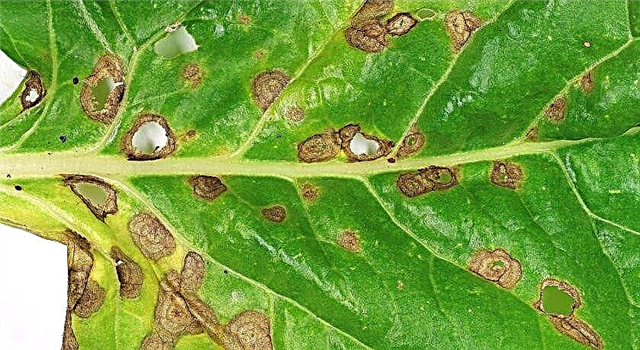
- Peronosporosis. The second name of the disease is downy mildew. This is a fungal disease, the first symptom of which is yellowing of the leaves, later on the tops are curled and dying. On the back of the affected leaves you can notice a brown coating. Prevention and treatment: cleaning the remnants of previous crops in the fall, seed disinfection. Regular treatment of crops is carried out during the growing season with systemic fungicides.

- Fusarium. Fungal disease of beet leaves and root crops. It manifests itself in the form of yellowing, wilting or discoloration of young leaves. Root crops affected by Fusarium disease do not grow well, in the future they become as if wooden. Prevention and treatment: top dressing with mineral and organic substances (top dressing with boron is especially important), applying lime to acidic soils, using crop rotation, regular watering and loosening.

The most dangerous beet pests:
- White beet nematode. One of the most dangerous pests in growing beets. Possible crop losses of up to 50%. These pests infect the soil, and subsequently root crops become infected. The presence of nematodes can be determined by the many small roots on beets - the “beard”. Prevention and treatment: the most important thing is compliance with crop rotation. When root crops are grown in a biennial culture (per seed), uninfected beet mother plants should be used.

- Weevil. A long beetle with a gray color of chitin, the length of the body is from 1 to 1.5 cm. It is very dangerous for young seedlings, because it feeds on leaves. Maybe in a few bites to eat young seedlings, leaving only the stem. The female lays eggs in the soil, the pest hibernates also in the soil. Prevention and control measures: soaking the seed in insecticides, if necessary, the newly emerged plants are treated with insecticides per leaf, annual use of crop rotation.

- Aphid. Small insects with a black or dark green body length from 1.7 to 2.7 mm. They feed on the juice of leaves, multiply rapidly, they can be seen with the naked eye. Insects are on the underside of the leaves and seed arrows. Prevention and treatment: the destruction of weeds in the beds, the cultivation of ladybirds, the treatment of crops with organophosphorus insecticides.

- Scale shield, or beet bug. It feeds on leaves, a large population can completely eat a young plant. The beetle has a brown or greenish shell color; the body length is 6–7 mm. Prevention and treatment: keeping the beet field clean of weeds, insecticide treatment at least twice a month.

Harvesting and storage
The commodity root crop Pablo F1 grows in 90–120 days. The early harvesting period is the cutting of young leaves to greens, which is produced in late June and July. Cutting is carried out regularly, as necessary. A part of the leaves is cut manually from the plant, while the root crop is not disturbed. Young beetroot leaves are the most delicious and contain the most valuable substances.
The selection of root crops is carried out gradually, in the summer - in July and August. Harvest from the entire plantation is harvested in late September and October. It is worth remembering that the fruits that suffered frosts are stored worse and less.Did you know? Beets have a rather high glycemic index (sugar content), therefore, the use of these root crops is not recommended for people suffering from diabetes.
Harvesting is carried out when root crops reach a characteristic size and shape, and the lower leaves of the aerial parts begin to turn yellow. Digging beets is carried out with care, so as not to damage it, as this significantly reduces storage time.

Storage conditions
Pablo F1 is a hybrid that is quite sensitive to storage conditions. Root crops are best stored at a temperature of +2 ... + 4 ° C in the refrigerator, where they do not lose their juiciness and freshness for three months. Basements or pantries are also suitable for storage, provided that a similar temperature is set there, there is constant ventilation, and air humidity is in the range of 95–98%. In such conditions, beets can be stored without losing their properties, up to 5 months.
Root crops with a diameter of 10-15 cm are best suited for storage. They must be healthy and intact, peeled and dried. Beets can be successfully stored next to other vegetables and root crops.
Red beet is one of the most popular and useful root crops. Pablo F1 hybrid stands out among other similar vegetables. To obtain a good harvest, the gardener must observe the early sowing dates and ensure that the plants receive proper care during the growing season (cultivation, weeding, thinning, processing from pests).Important! Beetroot leaves are eaten freshly picked because they quickly lose water and wilt. In the refrigerator, they can only be stored for 5–7 days. Beetroot greens can be frozen, in this form it is stored for several months and is used for making soups.
Network user reviews
ADVANTAGES: Yield, still, excellent taste, dark pulp without rings and beetroot smell and taste, root crops are not large.
DISADVANTAGES: None.
I greet the readers of my review! I met this beet variety by chance, I was looking for a variety of red beet dark, without rings, good keeping quality.In a tent with seeds, Pablo recommended and now I have been a fan of this variety for more than ten years. I plant this beet in the beds in early May, sprouts are friendly, appear ten days later. Seeds germinate almost one hundred percent. It’s a pity to break through, so I plant right away so as not to break through, and if I had to break through, I plant it on a free bed, it takes root well. The Pablo variety gives root crops not large, somewhere up to 150 grams, of an even rounded shape. The pulp is dark, juicy, uniform and without rings. Care for beet crops is simple: watering, weeding, top dressing. I often use beetroot leaves for making cabbage soup, borsch, salads. The beet has a pleasant, sweetish taste, the usual beet smell and taste are absent. I noticed that the leaves of this beet variety begin to turn yellow sooner than others and remain green until harvesting. I take root crops at the end of September. I cut the leaves with a 5 mm margin, clean them only in dry weather, clean them from the ground and leave them scattered on the floor in the barn. Two weeks later, I lower the beets in the basement for winter storage. Beets are stored well, there are practically no sweet root crops. It is stored in a wooden box until the month of June and does not germinate. Beets are good for cooking borsch, beetroot, vinaigrette, pastes, salads, cold soups. I recommend this variety for planting in a personal plot, the crop will be necessarily good.










